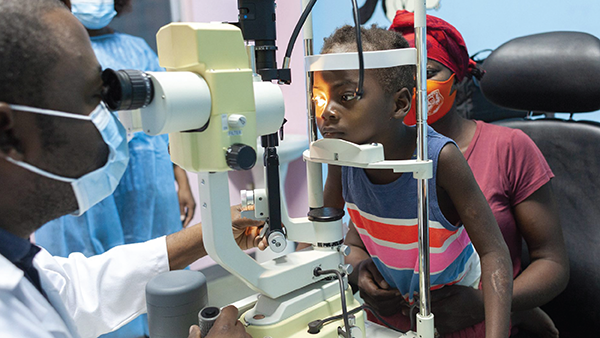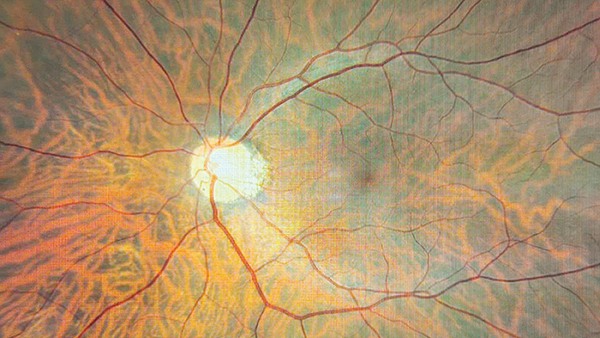The Opportunities of “Big Data”
Why we should all consider using the unprecedented amounts of data at our fingertips to improve eye care for all
When I was an undergraduate student at Rutgers University, I spent countless hours in the lab doing various types of bench work – whether running western blots or maintaining cell cultures. Even though I found great interest in this, it wasn’t until medical school that I discovered research isn’t limited to lab investigations. Here, I became fascinated by the prospect and power of "Big Data" to conduct meaningful investigations in ophthalmology and, I suppose, medicine overall.
We live in an era of unparalleled access to data – so much so that the phrase “the world at our fingertips” has never been more accurate. In recent decades, the way information can be accessed and knowledge gained has shifted dramatically. Gone are the days of sifting through massive journal compendiums and texts in the library for hours – or even days – to answer a single question. Smartphones now allow us to learn about anything, anytime, anywhere, and collaborate with anyone in mere minutes. In fact, the digitization of knowledge has made the goal of universal access to information a plausible reality for researchers worldwide.
Leveraging Big Data, in my opinion, is imperative to address questions that were previously logistical nightmares due to the complexities of data collection. Take the controversial topic of opioids, for example. A presidential declaration of a public health emergency was made in 2017, leading myself and my team to investigate differences between opioid prescribing patterns of subspecialties in ophthalmology. Without Big Data, this would require a considerable investment of time and resources to ensure a sufficient, accurate, and confidential degree of data from each individual ophthalmologist on their opioid prescribing patterns was acquired.
We instead used publicly available data from Medicare and performed the analysis in just a number of days – not to mention, this was at no cost or risk to patients. This approach helped us identify the existence of subspecialty, demographic, chronological, and regional trends for opioid prescribing patterns in ophthalmology (1). Now, as we continue to store more and more information digitally, the challenges presented with Big Data studies have less to do with “how will the data be acquired?”, but will be replaced with “does the data already exist and how can it be accessed?”.
As previously referenced, part of the allure of Big Data investigations is the efficiency with which they can be conducted to provide meaningful conclusions. Tools that can optimize the experimental design process further will only continue to add value; in recent years we have started to see the potential implications of artificial intelligence (AI) in both clinical ophthalmology and vision research. AI may be instrumental in how we rapidly collect, store, and find Big Data in the future.
The benefits of Big Data research are clear: large sample sizes provide massive statistical power, and readily available data saves time and cuts experimental design costs. Of course, these are but a few features that can significantly support research investigations. The concern, however, resides in the fact that Big Data solutions still have inherent limitations and must be handled in a responsible manner. Though many research questions can be answered with existing digital data, some inquiries require specific data points for the most accurate investigations. Analyzing retrospective data in these cases can be problematic, as potential confounding variables might not be included, and thus lead to faulty conclusions.
For ophthalmologists, the paragon of Big Data research is the IRIS registry – and rightfully so. It is the US’ first database exclusively committed to eye disease research, with data on over 72 million unique patients as of October 2023 (2). Yet, access to the IRIS registry is not readily available, and Big Data extends beyond large databases focused solely on vision research. As demonstrated by the example of opioid research, various medical and non-medical databases exist that can advance ophthalmology.
Let’s say you’re interested in exploring the impact of social determinants of health on rare ocular cancers. I would advise using the National Cancer Database instead of organizing a time-intensive survey questionnaire for patients (3). Or, if you have a question on the epidemiology of ocular injuries reporting to the emergency room in certain demographics, it would be worth first exploring the National Electronic Injury Surveillance System. This would serve as a faster alternative to developing a prospective investigation that accommodates the constraints of a busy emergency room and the unpredictability of what injuries will come through the door (4).
Big Data is not limited to written registries; image databases can now be used to test new AI tools and theories in ophthalmology (5). Big Data studies do not even require established registries. These studies may be “less Big,” but they can creatively answer important research questions otherwise difficult to explore. Most often, all the data is available online to the public and just needs to be compiled and analyzed. One study our group did to assess predictors of scholarly activity by ophthalmology residents involved compiling information from publicly available social media and PubMed profiles (6).
As we continue to become more technologically advanced and knowledge becomes digitized, it is our responsibility to use the unprecedented amount of data available to us to answer research questions that can improve eye care for all.
References
HS Choudhry, et al., “Interspecialty Opioid Prescribing Patterns in Ophthalmology Following Declaration of a Public Health Emergency,” Journal of Ocular Pharmacology and Therapeutics, 40, 1 (2024): PMID: 37878373
HS Choudhry, et al., “Significance of Social Determinants of Health in Tumor Presentation, Hospital Readmission, and Overall Survival in Ocular Oncology,” American journal of ophthalmology, 260 (2024). PMID: 37956780
HS Choudhry, et al., “Epidemiology of consumer-product-related ocular injuries in the geriatric population in the United States,” Ophthalmology and therapy, 13, 1. PMID: 37995015
AB Crane, et al., “Effect of simulated cataract on the accuracy of artificial intelligence in detecting diabetic retinopathy in color fundus photos,” Indian Journal of Ophthalmology, 72, 1. PMID: 38131541.
HS Choudhry, et al., “Impact of gap years following medical school graduation on resident research productivity in ophthalmology,” Journal of Academic Ophthalmology, 15, 02 (2023). PMID: 37701863.
The New Optometrist Newsletter
Permission Statement
By opting-in, you agree to receive email communications from The New Optometrist. You will stay up-to-date with optometry content, news, events and sponsors information.
You can view our privacy policy here
Most Popular
Sign up to The New Optometrist Updates
Permission Statement
By opting-in, you agree to receive email communications from The New Optometrist. You will stay up-to-date with optometry content, news, events and sponsors information.
You can view our privacy policy here
Sign up to The New Optometrist Updates
Permission Statement
By opting-in, you agree to receive email communications from The New Optometrist. You will stay up-to-date with optometry content, news, events and sponsors information.
You can view our privacy policy here









